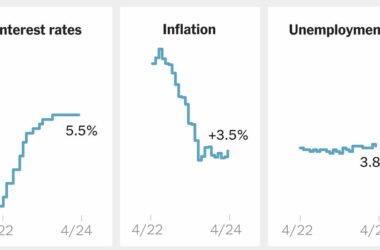An important query is hanging over the American financial system and the autumn presidential election: Why are shopper costs nonetheless rising uncomfortably quick, even after a sustained marketing campaign by the Federal Reserve to gradual the financial system by elevating rates of interest?
Economists and coverage consultants have provided a number of explanations. Some are primarily quirks of the present financial second, like a delayed, post-pandemic surge in the price of dwelling and auto insurance coverage. Others are long-running structural points, like a scarcity of inexpensive housing that has pushed up rents in massive cities like New York as would-be tenants compete for items.
However some economists, together with prime officers on the Worldwide Financial Fund, stated that the federal authorities bore a few of the blame as a result of it had continued to pump massive quantities of borrowed cash into the financial system at a time when the financial system didn’t want a fiscal enhance.
That borrowing is a results of a federal finances deficit that has been elevated by tax cuts and spending will increase. It’s serving to to gasoline demand for items and companies by channeling cash to corporations and individuals who then exit and spend it.
I.M.F. officers warned that the deficit was additionally growing costs. In a report earlier this month, they wrote that whereas America’s current financial efficiency was spectacular, it was fueled partly by a tempo of borrowing “that’s out of line with long-term fiscal sustainability.”
The I.M.F. stated that U.S. fiscal insurance policies had been including a few half a share level to the nationwide inflation charge and elevating “short-term dangers to the disinflation course of” — primarily saying that the federal government was working at cross-purposes with the Fed.
Biden administration economists, and a few analysts on Wall Road, reject that view. Administration officers stated that the evaluation underlying the I.M.F.’s claims was implausible. That’s partly as a result of the report discovered that federal coverage was including simply as a lot to inflation presently because it did two years in the past, at a time when direct funds to customers and different packages from President Biden’s 2021 stimulus invoice had been growing spending throughout the financial system.
Administration officers pointed to other measures of fiscal policy, together with a unbroken evaluation by the Brookings Establishment in Washington, that instructed that authorities tax and spending insurance policies weren’t considerably including to financial progress or inflation now or within the current previous.
“I don’t assume the current inflation document helps an extreme demand story,” Jared Bernstein, the chairman of the White Home Council of Financial Advisers, stated in an interview. “I feel what we’ve seen is that as provide chains have unsnarled, demand within the job market has cooled considerably. We’ve been in a position to keep traditionally low unemployment whereas getting important disinflation.”
Mr. Bernstein added that, whereas administration officers had been cautious to not touch upon the central financial institution’s rate of interest selections, “our fiscal stance is just not combating the Fed.”
The talk is vital for a way the Fed, which bears major accountability for controlling worth progress, units coverage within the months forward.
Traders entered the yr anticipating Fed officers to chop rates of interest a number of instances, after worth progress slowed quickly in 2023 and started to strategy the central financial institution’s goal stage of two % per yr. They’ve revised these forecasts as new information present that progress stalling out and, by many measures, starting to reverse.
How policymakers view the interaction between deficits and inflation might additionally form selections by the subsequent president and Congress. If re-elected, Mr. Biden stated that he would search to cut back deficits by about $3 trillion over a decade, primarily by elevating taxes on excessive earners and firms. His Republican opponent, former President Donald J. Trump, has repeated his previous — and unfulfilled — guarantees to eliminate the national debt, whereas additionally pushing for an extension of his 2017 tax cuts that might add trillions to deficits.
Each presidents’ insurance policies, together with selections by presidents earlier than them, have contributed to the nation’s present fiscal imbalance. The deficit spiked when Mr. Trump, after which Mr. Biden, signed reduction payments for folks and companies amid the coronavirus pandemic. It fell within the 2022 fiscal yr however successfully doubled final yr.
The deficit is now bigger, as a share of the financial system, than is traditionally regular for this level in an financial restoration — when unemployment is low and financial progress stays sturdy.
That’s even true when you exclude the prices of servicing the federal government’s mounting debt load, which jumped final yr because the Fed raised rates of interest, a measure economists name the “major deficit.” When correctly measured, the first deficit final yr was equal to about 5 % of the financial system’s annual output. Information from the nonpartisan Congressional Finances Workplace counsel that was the sixth-highest major deficit of any yr since 1962; the opposite 5 all got here throughout, or instantly after, the pandemic or the 2008 monetary disaster.
Excessive deficits might have an effect on inflation in just a few methods. They may enhance demand for items or companies that stay in comparatively quick provide, driving up costs. They may have an effect on customers’ views about how a lot inflation they count on sooner or later and chip away on the effectiveness of Fed charge will increase to gradual progress, stated Joseph H. Davis, the chief international economist at funding agency Vanguard.
Mr. Davis stated that the shift from a declining deficit to a rising one was more than likely including modestly to cost progress and making the Fed’s job tougher: “What was a tailwind on inflation has develop into extra of a headwind,” he stated.
The deficit enhance final yr mirrored a number of components, together with risky capital features tax collections and the results of pure disasters on tax submitting. In addition they mirrored elevated authorities spending and tax breaks signed into regulation by Mr. Biden. A bipartisan 2021 infrastructure invoice is now funding roads, broadband and different tasks nationwide. The federal government is paying for added well being advantages for veterans uncovered to poisonous burn pits.
Tax incentives in a bipartisan regulation meant to encourage semiconductor manufacturing and a party-line regulation meant to speed up the transition from fossil fuels to lower-emission power sources have spurred a whole lot of billions of {dollars} in bulletins or spending on new manufacturing unit development.
“It was a big dose of fiscal stimulus during the last yr,” stated Jason Furman, a Harvard economist who chaired the White Home Council of Financial Advisers below President Barack Obama. “To get folks decrease mortgage charges,” he added, “to offer companies the power to broaden and make investments and develop, we have to be bringing the deficit down.”
Information from different economists, just like the creators of the Hutchins Heart Fiscal Impression Measure at Brookings, counsel that the rise in spending and tax breaks final yr didn’t outweigh the drag on the financial system from expiring Covid reduction. In different phrases, they successfully present that the top of stimulus assist that propped up shopper demand within the early phases of the pandemic offset any elevated demand from new spending and tax breaks.
Economists on the funding financial institution UBS wrote final week that after including to progress final yr, together with by fueling manufacturing unit development, federal tax and spending coverage was prone to “flip” to dragging on progress this yr. Economists at Financial institution of America Securities made an identical case final week, after the Commerce Division reported financial progress slowed within the first months of this yr.
Administration officers stated there are easier — and superior — explanations for why worth progress stays above the Fed’s goal than the deficit. Housing inflation has not moderated as rapidly as many economists anticipated, although White Home fashions predict it is going to quickly. Worth progress in auto insurance coverage, monetary companies and medical companies are successfully one-offs which might be maintaining inflation elevated now, the officers stated, however won’t proceed to push costs increased within the months to return.
“It’s not likely a fiscal story,” Mr. Bernstein stated.




